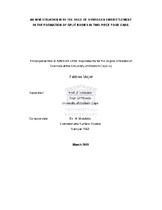| dc.description.abstract | Nampak packages millions of cans a year and a very small percentage of these cans fail due to many reasons. One of the main reasons that cause 2- piece food cans to fail is split flanges. Split Flanges arises due to a number of reasons which will be discussed in detail.The focus of this thesis was based on the causes of split flanges in 2-piece food cans. A study on manufacturing the steel and can making together with packaging fish in these cans was conducted. Another study on the reasons for split flanges occurring in 2 piece cans was conducted done as well.The purpose of the investigation was to check if hydrogen embrittlement could be the cause for split bodies forming in 2 piece food cans. 2 piece cans are drawn and wall ironed from tinplate; the cans were made up of a top and a shaped body. It was this shaped body that went through a considerable amount of stress during manufacture especially at the top of the can, which gave an explanation to why the cans split at the curved area near the flange of the can.According to previous studies done at Nampak R&D more complaints about split bodies were coming from the Fish canneries on the West Coast than the Vegetable canneries. These canneries used the exact same cans to package their product. The difference between the processes at these canneries was the exhaust boxes at the fish canneries. The exhaust box is a long tunnel filled with steam used to precook the fish; the vegetables are not precooked in exhaust boxes. Non metallic inclusions (NMI) was one of the main reason for these split flanges to occur and a reason of particular interest in this research.NMI’s were distributed throughout the steel of the cans and since the same cans were used for the fish and vegetable canneries, they should be failing at the same rate. Yet only complaints came from the fish canneries. So the primary focus of the research was to check if the additional steam process contributed to the formation of split bodies / flanges. We proposed to
investigate if hydrogen atoms collect at grain boundaries, vacancies and non metallic inclusions and also to check if the steam accelerated embrittlement. Hydrogen is believed to penetrate right into the bare steel of the cans that were exposed to steam.Hydrogen atoms are being investigated because of their small size, their ability to diffuse through a metal lattice and form hydrogen molecules within the intermetallic vacancies of the metal. The molecules of hydrogen, once
formed within the internal structure of the metal, remain trapped because of their larger size and can generate a significant pressure that can contribute to the formation of split bodies. [1] The first step to prove whether H-embrittlement was present in the cans was to check if hydrogen was present. A spectroscopic method namely, elastic recoil detection analysis (ERDA) was used to check if H could be detected using the Elastic Recoil Detection Analysis technique. Several experiments
were designed to make sure the technique was suitable for the detection of H.
Even though it is known that all metals are susceptible to corrosion and Hembrittlement, the tinplate metals had to be checked in an environment similar
to the exhaust box (suspected area causing hydrogen embrittlement) in the
factories.Further characterization was done using X-Ray Diffraction to measure the
residual stress and relate it to the effects of H-embrittlement. If the H had penetrated into the metal it would cause some distortion in the atomic distances between the atomic planes in Fe atoms and can be measured using XRD.Another effect of hydrogen embrittlement is to reduce the strength in the metal. Tensile tests were performed to measure the strengths of the metal. | en_US |

